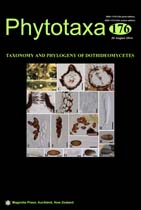Abstract
In the Outline of Ascomycota 2009, 116 genera were listed under Dothideomycetes, genera incertae cedis. In the present study, we re-examined the generic types of Ascostratum, Chaetoscutula, Ceratocarpia, Cystocoleus and Colensoniella which are relatively poorly documented. We re-described and illustrated the type species of these genera and suggest higher level placements based on a modern classification system. Ascostratum is placed in Myriangiaceae because of similarities with Anhelia, both genera have ascostromata with numerous locules in the upper part and 4–7 transversely septate ascospores. Chaetoscutula is similar to Pododimeria in having the same host and septate, olivaceous-brown ascospores and thus is transferred to Pseudoperisporiaceae. Colensoniella has apothecioid ascomata but 1-septate oblong, uniseriately ascospores that many break in the centre form part-spores and is referred to Patellariaceae. Cystocoleus is a typical of any family of Dothideomycetes, but phylogenetic analysis showed this genus to cluster in Capnodiales incertae sedis. Ceratocarpia has glabrous ascomata, muriform ascospores and evanescent pseudoparaphyses so placed in Chaetothyriaceae. By illustrating the genera we hope to stimulate fresh collections so that these genera can be epitypified and molecular data analyzed to establish a truly natural classification.

